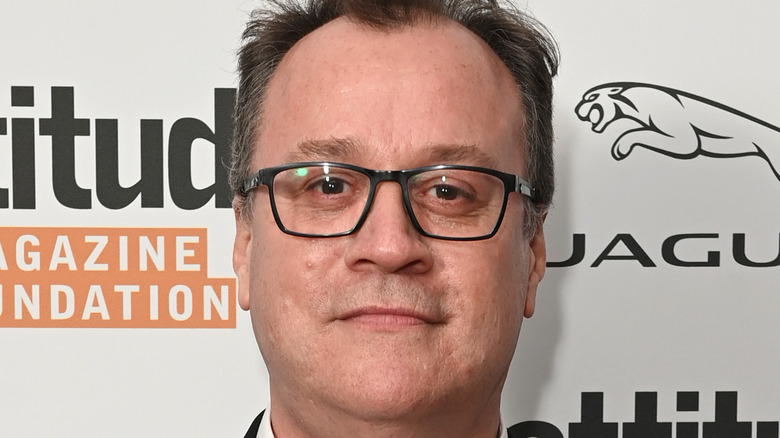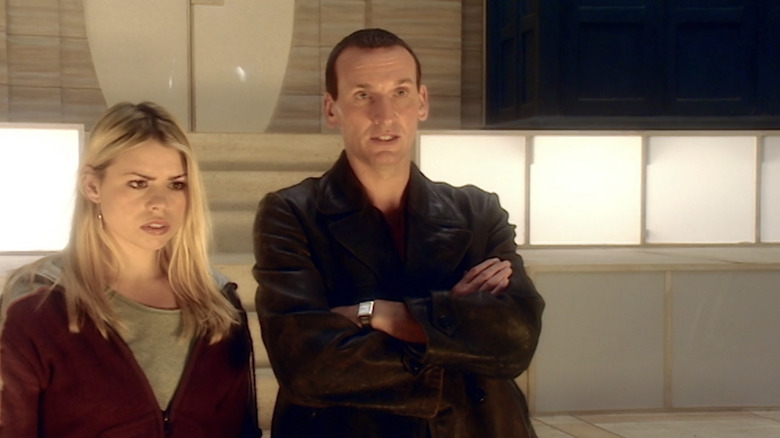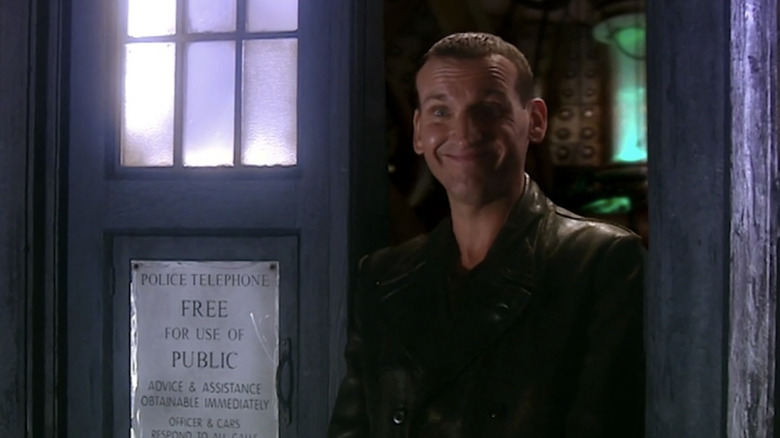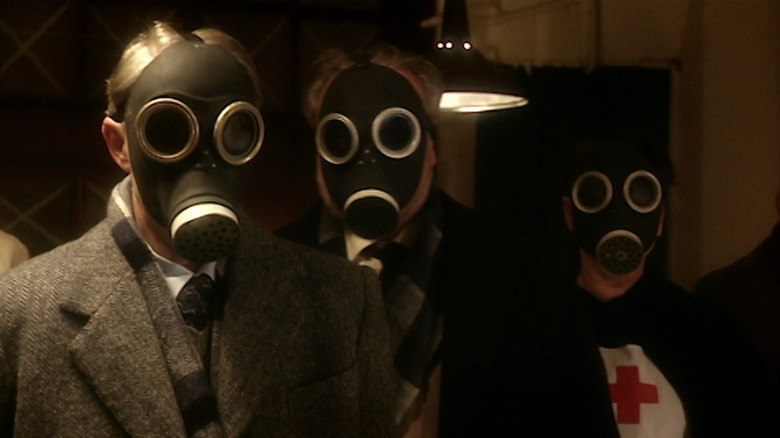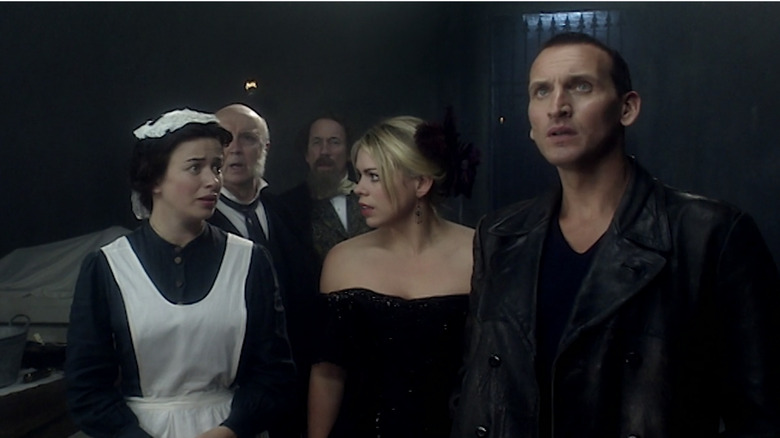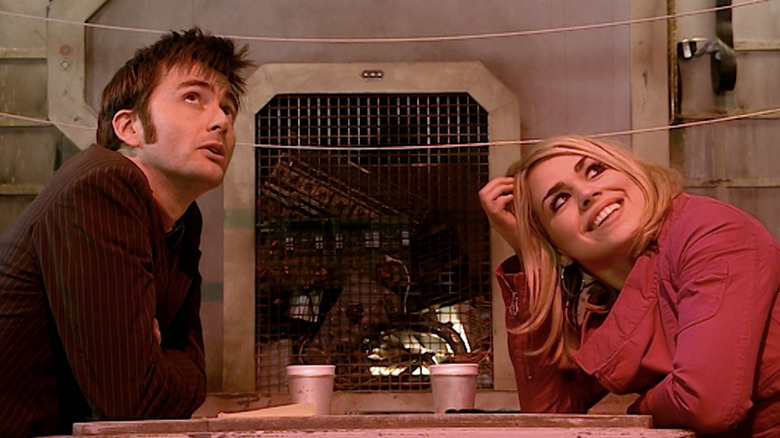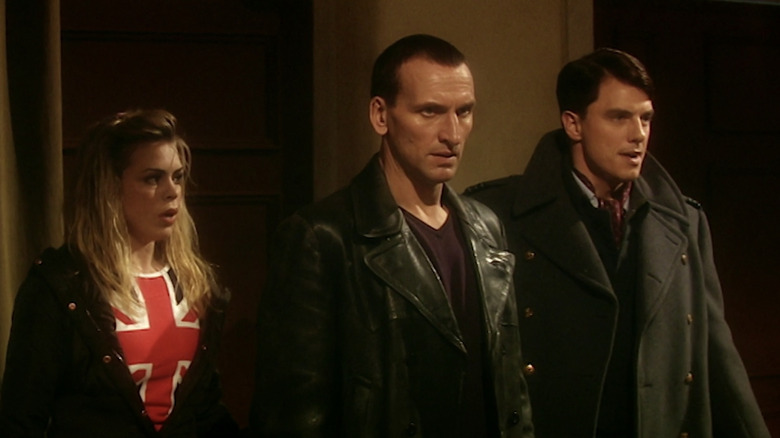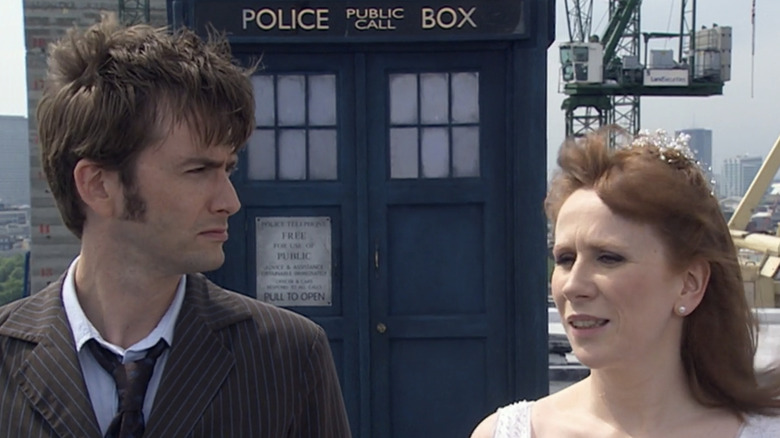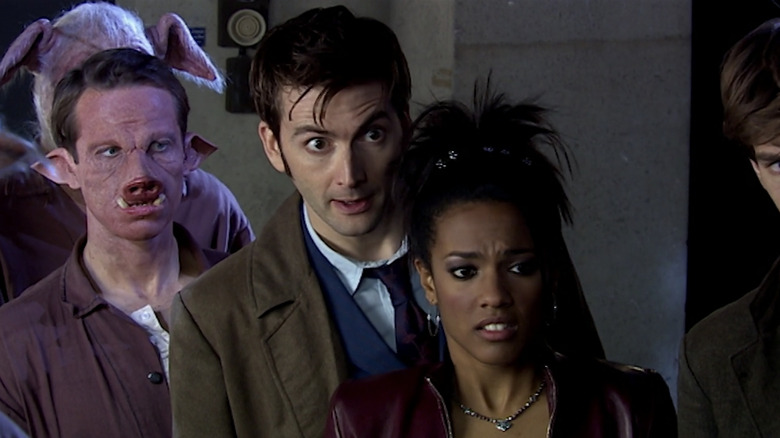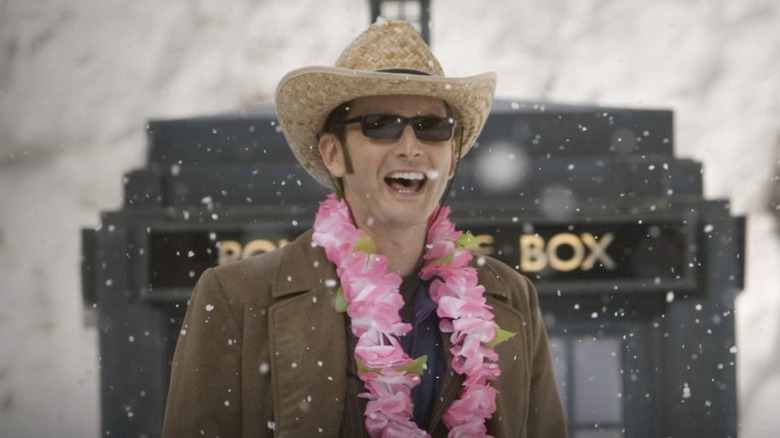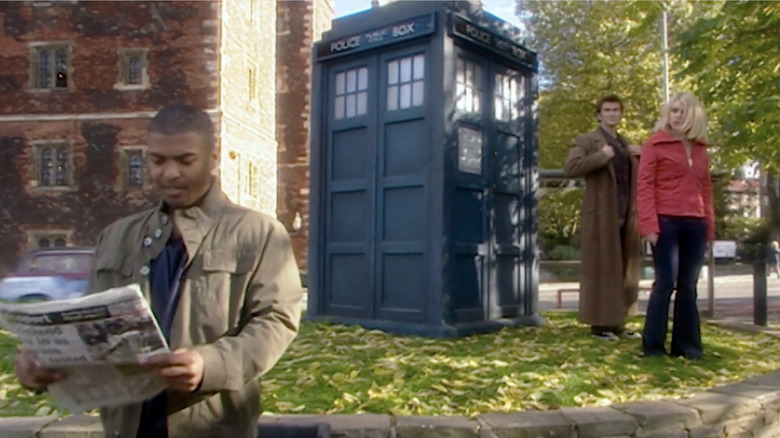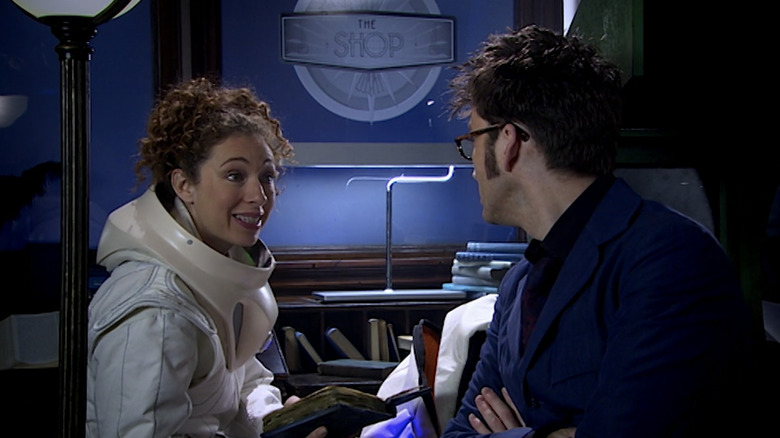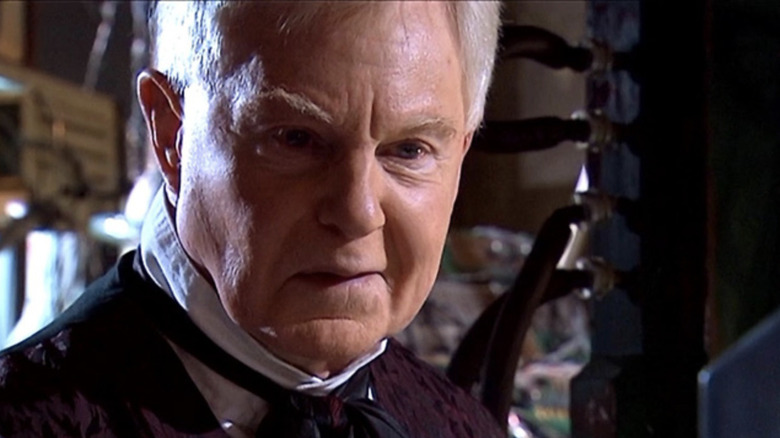How Russell T Davies Changed Doctor Who Forever
When news broke that former "Doctor Who" showrunner Russell T Davies would be returning to oversee the show again in 2023, fans started discussing and rediscovering the episodes he helmed from 2005-'09 for hints at what might be in store. Davies' Chris Eccleston-led "Doctor Who" reinvention was the franchise's first new series since 1989, bringing back the British icon in a way nobody expected.
It all started in the late 1990s. With American imports like "Star Trek: The Next Generation," "The X-Files," and "Stargate: SG-1" doing well for them, the BBC wanted to create a show that could appeal to the same demographic as those programs. After an attempt at licensing "Buffy the Vampire Slayer" characters from Fox Television in the US for a BBC-produced Professor Giles spinoff fell apart, and after other attempts at original sci-fi shows failed, the studio turned to its biggest classic property, and the decision was made to bring "Doctor Who" back to television.
The studio didn't have to search long for someone to take the reins. An up-and-coming producer named Russell T Davies leapt to the forefront, eager to be the person in charge of resurrecting his favorite franchise. Ultimately this new version of "Doctor Who" became the blueprint of everything that has come since — and it was so good, so creatively successful, that even former BBC executive Michael Grade, who famously hated the franchise and claimed a revival could never work, was forced to offer his begrudging admiration.
But how did Davies do it?
Doctor Who deconstructed
In the initial pitch Davies made to the BBC, one can see his plan to go back to basics. Learning lessons from watching it all his life — what worked, what didn't, and what it meant to tell a great "Doctor Who" story — he deconstructed the entire concept. After 40 years, "Doctor Who" needed to be taken apart before it could be put back together again.
So Davies wisely stripped it down to its core elements. No more crazy outfits for the Doctor, no more wacky affectations — this Doctor was back to basics, a trend that largely continues today. The Tenth Doctor's most odd accessories were his glasses, Eleven his bow tie. The Doctors we've had since Davies have been so visually unremarkable that Jodie Whittaker's rainbow stripe caused quite a stir when her outfit was unveiled. The stories also got back to the core of what made the series great. It was more than alien monsters, more than complex backstory. Each episode was a simple morality tale with a straightforward yet intriguing plot.
Over the course of Davies' three years as showrunner, the new mythology of "Doctor Who" began to take shape, as he, the writers and other producers slowly reconstructed the series from the ground up. Which makes one wonder: With all the twists, turns, controversial storylines, and new complex backstory of the past few years, could Russell T Davies be planning to deconstruct the Doctor once again?
High concept, prestige drama
"Unashamedly high concept" is the way Davies emphatically put it in his original series pitch. More than "bad alien of the week" episodes, these were to be big stories with big ideas, filled with compelling characters. Invoking other prestige programs like "Buffy" and "Angel," he pitched an ongoing story buried within seven single episodes and trio of two-parters.
And the two-parters needed to justify their heft, Davies argued, saying he wanted them to "earn their size, like American sweeps." No longer the domain of children's entertainment or teatime programming, "Doctor Who" would be a serious (if family-friendly) drama, and Davies' earliest episode synopses reflected that: Given a coveted primetime slot, he felt comfortable going to darker places, with more serious issues in play.
With a keen understanding of how his stories would become part of an enduring franchise lore, Davies used the new 13-episode, ten-story format to craft well-written, highly polished scripts. Unlike the "Classic Who" series that could churn out 20 or 30 episodes a year (or more than 40 in its early years), meticulously planning everything out and limiting the episode count allowed Davies to focus on the best stories in a well-planned and well-executed series.
He made it scary ... and sad
Classic "Doctor Who" had some spooky elements, but usually in the form of odd-looking monsters or creepy make-up effects. And though the melodrama may have induced a few sad faces at times, the producers weren't exactly out to draw tears from an audience of mostly children.
But Davies' "Doctor Who" changed all that. His series wasn't aimed at children (though it was of course family-friendly), which provided him the opportunity to do something we hadn't seen before: A genuinely frightening, and seriously emotional, "Doctor Who." Certainly it was no horror show, but the scares were real. And the drama wasn't going to send you into a depression, but when Rose practically begs the Doctor not to go and must watch him change in "The Parting of the Ways," many if not most viewers shed a tear.
In the acclaimed "The Empty Child," we meet children with WWII-era gas masks fused to their very faces. They point at the Doctor and ask, in a droll monotone, "Are you my mommy?" It's enough to make your skin crawl, and remains one of the most unsettling moments of the franchise. Tear-inducing, terrifying moments became the norm, continuing into Steve Moffat and Chris Chibnall's tenures, with more than a few memorable moments forcing emotions out of its viewers in ways nobody anticipated.
Reinventing the Doctor for the 21st century
Compassionate, sassy, and brave, Christopher Eccleston was a reinvention of the Doctor. It had been more than 15 years since the show went off the air, and Russell T Davies knew that the same old tricks wouldn't work. No longer would the Doctor be the posh alien adventurer in fancy dress for whom travels through time and space were ho-hum; no longer would he be the stuffy proper Englishman we had known the previous five decades through eight different incarnations.
Davies wanted the Doctor to be full of wisdom, but also sexy, in a manner previous doctors had never been; a more relatable everyman, particularly in his style of dress, right down to his paradoxically down-to-Earth clothing. A seemingly working-class northerner, the Doctor was often just as awestruck as his companions at the wonders of the universe. The Ninth Doctor would have a touch of Troughton's good nature, would be dour like Colin Baker, would have a twinkle in his eye like Pertwee. But this Doctor would be much more likely to sneak off for a pint after an adventure.
In his original pitch to the BBC, Davies pointed to loneliness as the single biggest thing that makes Eccleston's Doctor stand out against his predecessors. The Ninth Doctor is the "The Last Of the Time Lords." Eccleston's Doctor has no family, but needs companionship.
That's where Rose Tyler comes in.
A more ordinary sidekick
Previous Doctor Who companion Ian Chesterton had been a history teacher. Nyssa, another companion, was a genius scientist, while a third, Jamie McCrimmon, was a Highland Scot from the mid-18th century. Davies wanted his Doctor's companions to be ordinary — and to that end, his first, Rose, was a teenage girl who lived at home and worked in a shop. She was designed to be someone aspirational, allowing viewers to see themselves.
Though companions had always been a stand-in for the audience, a conduit into the world of Doctor Who, the companions Davies dreamed up were the personification of the ordinary young adults the show wanted to attract. Rose Tyler, Mickey, Donna, and the companions that would follow were more than audience surrogates — they were the audience, in a very direct way.
Beyond Davies' tenure, we can see how this influenced the series that followed, with the likes of Amy Pond, Rory Williams, Clara Oswald, and Bill Potts. They all had different qualities that you'd find in ordinary "Doctor Who" viewers, allowing audiences to see themselves as companions of the Doctor.
An infusion of new blood
Davies didn't just assemble a team of quality writers, but a team of Doctor Who fans with diverse writing credits, infusing the production with sorely needed new blood.
Steven Moffat was a successful TV writer by 2005, but had also written "The Curse of the Fatal Death," a 1999 "Doctor Who" story that starred Jonathan Pryce, Rowan Atkinson, and Hugh Grant. Moffat would introduce some of the most popular and enduring characters in "Doctor Who" lore, including Captain Jack Harkness and River Song, and would eventually succeed Davies as showrunner in 2010. Mark Gatiss was one of the first new writers recruited by Davies and Moffat, on the strength of the "Doctor Who" novels and radio dramas he had written (some of which had started out as fan-made productions). He would later go on to create "Sherlock" with Moffat, even appearing in front of the camera as Holmes' brother Mycroft.
Other writers like Paul Cornell, Robert Shearman, and Gareth Roberts were pulled from the world of comics, novels, and radio plays, out of Davies' respect for those mediums. He was able to recognize and reward those who had dedicated their time to producing high-quality Doctor Who stories during what became known as the "wilderness years": The decade and a half between the Seventh Doctor's final bow in 1989 and the debut of the new "Doctor Who" in 2005. Most of these new-to-television writers would later go on to write for other programs.
Intriguing mysteries
When we first encounter the Doctor in Davies' era, we meet a man hiding a deep trauma. Something happened between when we last saw him and the present. It seems clear he has not had a companion — and perhaps any interaction with mankind — in some time. The Doctor reveals he is the sole survivor of an event so cataclysmic it destroyed his entire world, and all of its people. What was this cataclysm, and why does the Doctor seem to carry such guilt over it?
It would be nearly a decade before we would get all the answers to the mystery of the Time War. It would be two more incarnations (plus another that had been kept secret) — and an entirely different showrunner — before it was finally all tied up in the multi-Doctor story and 50th anniversary special "The Day of the Doctor" in 2013. Storylines like the origin of River Song took years to pay off, and it was those ongoing mysteries that helped keep audiences coming back week after week, year after year. It prompted passionate discussion and speculation — particularly online, where fans of all kinds had started gathering in the years since "Doctor Who" ended its original run in 1989.
On message boards and fan websites, in the days before social media and YouTube, these mysteries gave the fans something talk about in the long gaps between series, ensuring a rabid and ready audience for each year's first new episode.
A new mythology (and some of the old)
As Russell T Davies wrote in his original "Doctor Who" pitch, "We'll ignore [the mythology]. Except the good bits."
It was clear from the very beginning that this new Doctor Who would not lean heavily on decades of established backstory, but wouldn't ignore it either. It didn't matter "that in 1973 he used gadget X to escape from planet Y" — but he wasn't afraid to reintroduce the likes of Daleks, or even the much-maligned K-9, or many other classic villains. Many within the BBC had wanted to ignore the old mythology, pitches from other writers going so far as to reboot the franchise entirely, fearing the property's reputation as kids' fodder would attract mockery.
Davies was all too aware of how the show would be dissected, and rather than draw from the mythology just to satisfy longtime fans, he pulled from it because he knew that what had worked in the past was worth keeping. Daleks would return, looking just as they always had, with a bit of a polish and color upgrade — just one example of the way Davies ultimately understood what could be changed and what shouldn't be, what should be brought back, and what should be new.
Respecting non-canon sources
Thanks to Russell T Davies, "Doctor Who" material that had been published during the wilderness years was no longer a mere diversion for fans. No longer were the comic strips and novels and audio dramas simply stories that were fun but weren't really part of the story we saw onscreen. Now they were the basis for actual episodes, with many elements being made official canon. This new tradition marked a seismic shift that garnered the respect and love of fans who'd followed the Doctor's offscreen adventures for decades.
For example, the first Dalek story in Davies' first series, written by Rob Shearman, is essentially a reinterpretation of Shearman's own Big Finish audio drama "Jubilee," starring Sixth Doctor Colin Baker. Even the Dalek's new redesign, while a return to its classic 1960s roots, pulled some visual elements from the non-canon Peter Cushing-led theatrical films. This tradition continued in "The Night of the Doctor" in 2013 by Steven Moffat, when returning Eighth Doctor Paul McGann rattled off a list of his companions, some of which had only ever appeared outside of the televised programs.
Davies has an acute understanding of what made "Doctor Who" great, and he recognizes it wherever it originated — whether a classic TV serial, a fan-made audio play, or a children's comic strip.
A focus on the companions
In his "Doctor Who" pitch, Davies summed it up as "a girl meets an alien," not "an alien meets a girl." The first episode of his tenure appropriately set the tone for what was to come, and it did so with such effectiveness that it could be called the blueprint for the show.
Beginning not in space, on another world, or even in the Tardis, the episode — called simply "Rose" — starts with eventual companion Rose Tyler, on Earth, going about her daily life. Before we get to know the Doctor, we get to know Rose, through her family, friends, and day-to-day life. This opening tells the audience we are in the real world, the ordinary world, and lulls us into a safe place — Rose's life — before she is thrust into the amazing, astounding, terrifying, magical world of the Doctor. Contrasted with her life, the Doctor's universe of Autons, Oods, and Slitheen seems that much more awe-inspiring.
Davies' "Doctor Who" is not the journey of the Doctor, but the journey of the companion. Episodes follow Rose as she's swept up by the force of nature that is The Doctor like a plastic deck chair in a raging storm. The companions are the Doctor's alter ego in a way; his human side manifest. They're his conscience, his advisors, more than mere assistants.
Developing characters & relationships
Russell T Davies was able to take advantage of his position as "Doctor Who" head writer and showrunner to bring a new kind character-driven storytelling to the show. Writing an entire series at a time allowed for real focus on characters like Rose, Mickey, and even the Doctor himself, empowering them to grow and change across multiple episodes, despite having fewer of them than even Colin Baker's short-lived Sixth Doctor. Davies and his writers developed these relationships in ways the program had arguably never done before. Rose and the Doctor, Rose and Mickey, Rose and her mother, the Doctor and Mickey — their relationships were never static, and evolved over the course of the series.
And he introduced new kinds of relationships, too, as his original pitch described the love between the Doctor and Rose. These were two people not necessarily in love, but soulmates of the highest order. Just as the Doctor would take Rose on adventures that would turn her world upside down, leaving her a different person than she was when we met her, he would also change her emotionally. And so too would Rose and her relationship with him likewise change the Doctor.
Powerhouse performers
When the new "Doctor Who" was first announced, fans dreamed of the big names that might headline as the Doctor, his companions, or the many famous villains. The likes of Richard E. Grant and Bill Nighy were heavily rumored in the early days, but realistically, the producers never suspected that a star like Christopher Eccleston would lead the series upon its debut. Billie Piper was also well-known, and the duo gave the show instant star power. Over the first three series, fans saw Derek Jacobi, Kylie Minogue, Freeman Agyeman, and Catherine Tate appear on the show in recurring roles or even as series regulars.
Having these powerhouse performers on board lent the show an air of respectability, forcing audiences to take it seriously and doing away with the studio's fear that this new incarnation would be mocked or derided as children's fare.
As the series continued, it attracted more and bigger names, from Timothy Dalton to "E.R." star Alex Kingston, and later the likes of Ian McKellan, Michael Gambon, David Warner, and Richard E. Grant (finally in a proper role after all those years of rumors). Even more recently, stars such as Stephen Fry and Alan Cumming have appeared, as "Doctor Who" continues to attract some of the biggest names and most well-respected acting talents in Britain and beyond.
